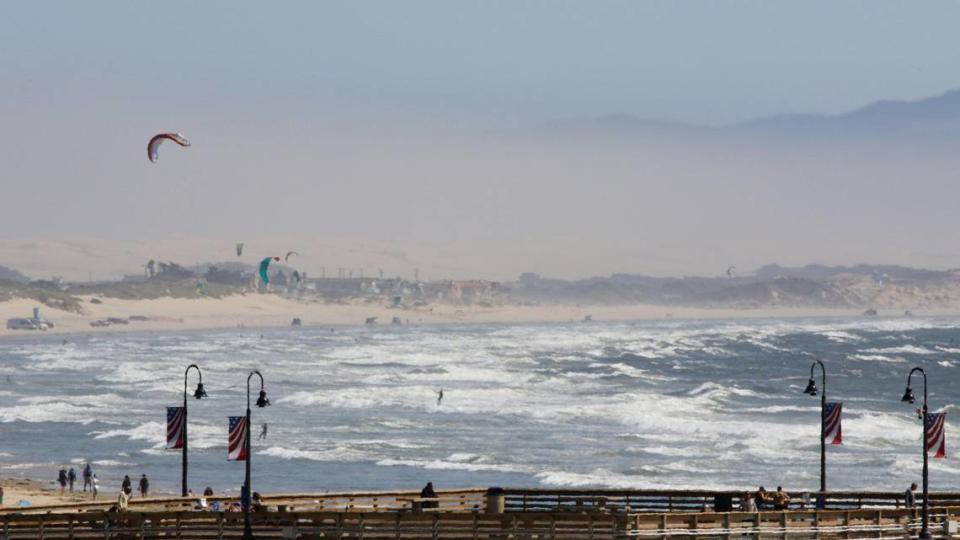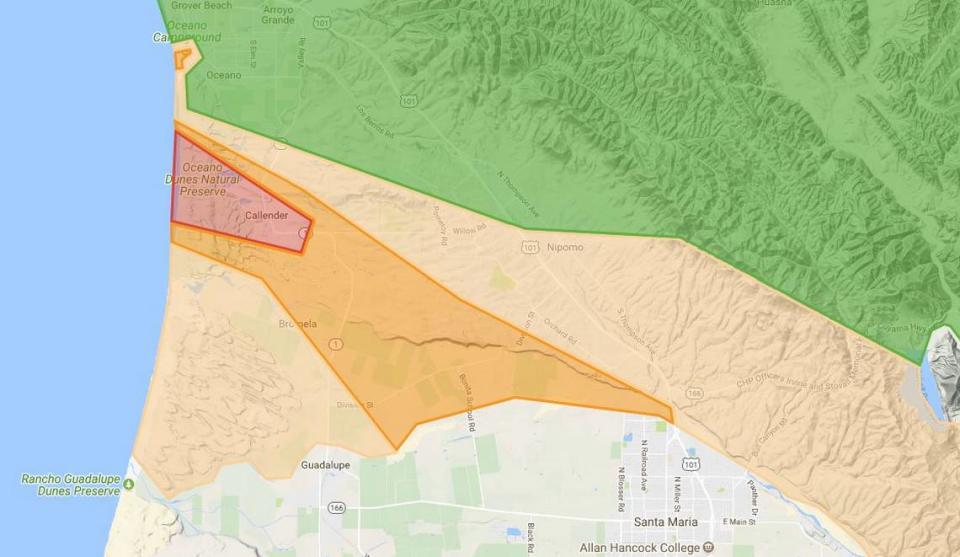Does Oceano Dunes blowing dust cause bad air quality? New study raises familiar controversy
A new study on dust emissions from Oceano Dunes State Vehicular Recreation Area that blow into southwestern San Luis Obispo County has resurfaced a decades-old debate over the pollution’s origins.
The study, published on Nov. 8 and authored by Lynn Russell of UC San Diego’s Scripps Institution of Oceanography, looked into the content of the pollution measured over 30 days at one site on the Nipomo Mesa.
From April 26 to May 26, researchers found that so-called “mineral dust,” or the fine particulate matter blown in from the sandy Oceano Dunes, comprised about 14% — or between 2% and 32% — of the average pollution measured on the mesa.
The finding contradicts what the San Luis Obispo County Air Pollution Control District (APCD) has long said — that the heavy pollution sometimes seen shrouding the communities downwind of the dunes is nearly all dunes dust.
The district used that assumption as its basis to require California State Parks to cut the dust emissions from the Oceano Dunes in half.
The APCD and a scientific advisory group told the state Off-Highway Motor Vehicle Recreation Commission that they are “critical of many parts of the report” and dispute the principal findings.
The commission will discuss the Scripps study in its next meeting on Dec. 9.
The scientific advisory group consists of air quality experts from around the country and was formed in 2018 to assist State Parks and the APCD with Oceano Dunes dust mitigation efforts as part of a court-issued stipulated order of abatement.
Russell said her study “points out their (APCD’s) failure to measure the quantity (of mineral dust in the air) that justifies the stipulated order of abatement.”
The APCD and scientific advisory group argue Russell’s samples were collected improperly, rendering her results invalid, while Russell asserts her methods square up just fine.
“These numbers they’re reporting are not consistent with what we’ve seen before and I suspect the main reason for that is that the samples were not collected properly,” said Karl Tupper, the APCD’s senior air quality scientist.
Our methods “are really standard,” Russell said. “There’s nothing sort of different or controversial about what we’re doing.”

Windy days mean bad air quality for Nipomo Mesa residents
The Scripps study revives a familiar question for many: What are people breathing in on windy, dusty days on the Nipomo Mesa? Is it Oceano Dunes dust?
As a rule of thumb, windy days in southern San Luis Obispo County mean air quality there tanks as the particulate matter (PM) levels measured on the Nipomo Mesa skyrocket. Residents shut themselves indoors to avoid the potentially harmful health impacts of the dirty air.
On May 19, 20 and 25, the APCD issued “better breather alerts” warning residents of “deteriorating air quality in the Oceano Dunes/Nipomo Mesa area due to blowing dust and sand.”
As wind gusts peaked, PM10 levels — inhalable particles with diameters that are 10 micrometers and smaller such as dust, pollen and mold — rose to as high as 363 micrograms per cubic meter on May 20.
Anything greater than 150 is considered unhealthy for anyone to breathe, according to the U.S. Environmental Protection Agency.
On the same windy days, the air quality in the rest of San Luis Obispo County remains good, according to air pollution control district data.
If you look at the Oceano Dunes on a windy day, you’ll likely see the dust blowing inland.
Maps created by the air pollution control district from data gathered at air monitoring stations in the region show how a plume of dusty air starts over the dunes and dissipates as it blows further inland toward Santa Maria.

But the particle content of the pollution remains debated. State Parks funded the Scripps study and has funded another study by the APCD to essentially answer the same question.
“That is the fundamental question: What is in the samples? What were the constituents of the PM10?” Tupper said.
The results from the air pollution control district’s study are expected to be released in early 2022, according to Tupper.
Dust mitigation efforts at Oceano Dunes throw Scripps study into question
It’s hard to say what impact the results from either study will have on the dust mitigation efforts at the Oceano Dunes.
Those efforts — which include sand fencing, growing natural dunes where vehicles previously drove and revegetating areas — have likely contributed to a decrease in bad air quality days on the Nipomo Mesa, according to an analysis by the air pollution control district.
2020 was a particularly windy year for the Oceano Dunes. The APCD measured more windy days in 2020 than in any of the five years prior, according to Tupper.
But the number of hours where PM10 levels exceeded 300 micrograms per cubic meter significantly decreased, according to the APCD’s data.
In 2020, there were just four hours where PM10 levels on the Mesa exceeded 300 micrograms per cubic meter. That’s compared to 54 hours in 2019, 52 in 2018, and 100 in 2017, according to the APCD.
A study conducted by the Desert Research Institute in Nevada found that a dramatic decrease in dust pollution in 2020 likely resulted from when vehicles were banned from the Oceano Dunes during a coronavirus-related shutdown that year.
These results again cause Tupper to be skeptical of Russell’s results.
“So if dust from the Oceano Dunes has nothing to do with the PM levels that we’re measuring downwind, then why are these mitigations seeming to affect the (PM) levels that we measure downwind?” Tupper asked.

